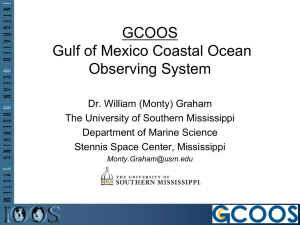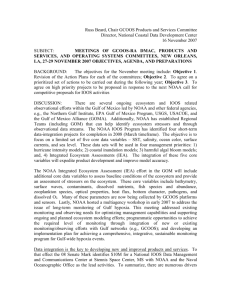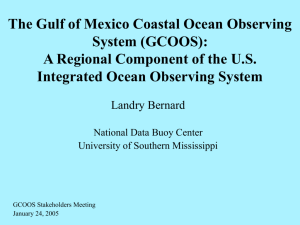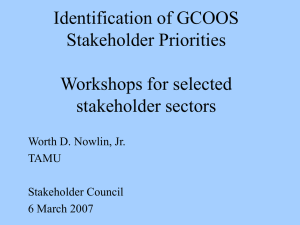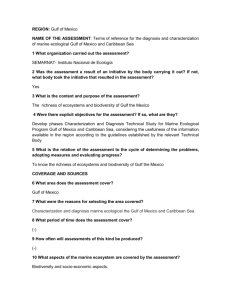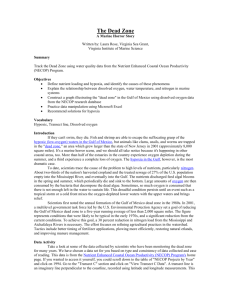GCOOS_Generic - Gulf of Mexico Coastal Ocean Observing
advertisement
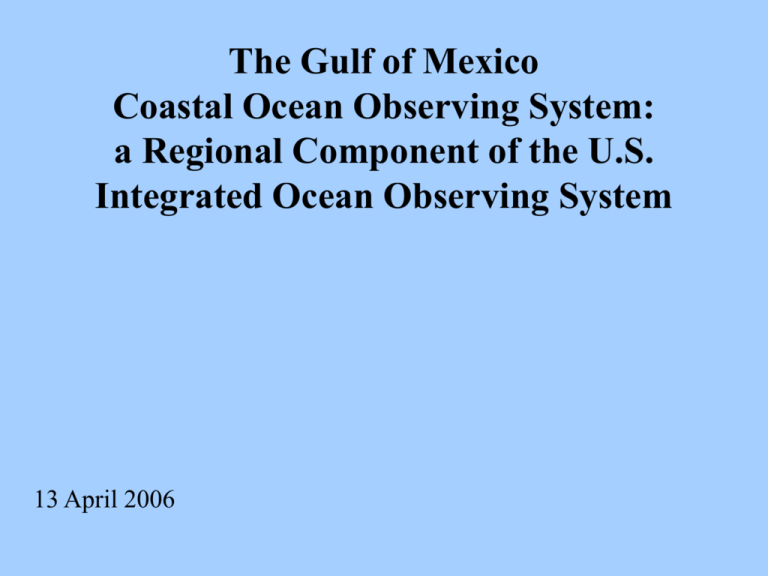
The Gulf of Mexico Coastal Ocean Observing System: a Regional Component of the U.S. Integrated Ocean Observing System 13 April 2006 Outline • Background • Existing Capabilities in the Gulf of Mexico • Actions to date in building the Gulf of Mexico Coastal Ocean Observing System • Next steps in that development Background U.S. IOOS Two Interdependent Components Global Ocean Climate Component GOOS/GCOS H Isl Coastal Ocean Component GLs GoA NE MAB Regional Observing Systems NW C Cal S Cal SE Caribbean National Backbone Go Mex National Backbone Coastal Component Regional COOSs • Operated by Regional Associations • Involve private & public sectors • Inform Federal Agencies of user needs • Enhance the backbone based on user needs • Incorporate Sub–regional systems • Operated by Federal Agencies • EEZ & Great Lakes • Core variables required by regions & Federal Agencies • Networks of sentinel & reference stations • Standards/Protocols Existing Capabilities in the Gulf of Mexico • Many existing elements are being used as the initial building blocks for a regional ocean observing system for the Gulf of Mexico. • These include continuing observations, satellite products, models, and other data products. • They are supported by local, state and federal government, private industry, NGOs, and academia. • They provide information that will have broader uses when they are integrated and enhanced. Building Blocks 1: In situ observations Gulf of Mexico observations 9of9_tabs_08262004b.gif TCOON Network http://tcoon.cbi.tamucc.edu/TCOON/HomePage TCOON Station 031: Seadrift 28° 24.4’ N, 96° 42.7’ W San Antonio Bay, Texas Houston/Galveston PORTS observation locations http://co-ops.nos.noaa.gov/images/hgports.gif MMS NDBC buoy data Cajun Express Walker Ridge 29 BAYWATCH - Louisiana State University Nan Walker • Currently 5 stations • Full suite meteorological • 3 Hydrographic Values • Samples are taken every 10 seconds • Minute, hourly, and daily summaries are recorded • Data display is updated on the web every minute • Archive Data available Long-Term Estuary Assessment Group (LEAG) NOAA: Science in Service of Policy in the Mississippi River / Gulf of Mexico Estuary Modeling and Processes Technical Working Group Tier 1. Processes 1. Acoustic Mapping (Allison, TU) 2. Biogeochemical Material Fluxes (McKee, TU) 3. Nitrate Monitoring (Dagg, LUMCON) 4. Geochemical Sampling (Bianchi, TU) 5. Strontium Geochemistry (Marcantonio, TU) 6. Pharmaceutically Active Compounds (Wang, XU) 7. Research Cruises (Dagg, LUMCON) Tier Two: Modeling 1. Sediment Transport (Michaelides, TU) 2. Mixing and Transport (Eschenazi , XU) 3. Modeling Transport in Rivers, Estuaries and Coastal Environments (Jobst, NRL/NAVO) Tier Three: Linkages 1. Data Management and Linkages Among Models, Monitoring and Processes (Dagg, LUMCON) USGS: Nexus of Science in the Lower Mississippi River and Gulf of Mexico Project Period: 7/1/02-8/31/03 Sensors, Platforms, and Markers Technical Working Group Tier 1. Biosensors and Platforms Development, integration, test, and evaluation of biosensor in autonomous underwater vehicle (Rey, COTS; Blake, TU; Blake, XU) Tier 2. Biomarkers in the Environment 1. Trace Gases of Microbial Flora as a Biomarker of Pollution (Boopathy, Nicholls) 2. Reproductive Status of Amphibians as a Biomarker of Pollution (Lafleur, Nicholls) 3. Molting in Fiddler Crabs as a Biomarker of Pollution (Zou, Nicholls) Informatics Education Technical Working Group Technical Working Group Tasks 1. Integration of environmental sciences into high school curriculum 2. Students participate in field research 3. Students as Teachers (Wilson, CBR) • Spatial analysis of Mississippi bathymetry • GIS data development for other TWGs • Mapping/analysis of AUV pollutant data data • Online GIS • Support Education TWG in GIS training • Develop maps and cartographic products in support of all project efforts. (Meffert, CBR) WAVCIS - Wave-Current Surge Information System For Coastal Louisiana http://csi.lsu.edu/ The University of Southern Mississippi CODAR Coverage The University of Southern Mississippi Tampa Bay PORTS observation locations http://co-ops.nos.noaa.gov/images/tbports.gif University of South Florida COMPS QuickTime™ and a TIFF (Uncompressed) decompressor are needed to see this picture. http://comps.marine.usf.edu/index.html Building Blocks 2: Remotely sensed data and products Satellite Products Model Products Products At present, there are only a limited number of products derived from measurements being made in the Gulf. Some were mentioned earlier. As expected, most of these products are derived from specific observations for purposes specified by the entities paying for the observations. (Exceptions include satellite products.) If the observations were combined with one another, many new data-products could be produced that would benefit additional sectors of users. Us er Sector Recreational Activities Transportation Health and Safety Energy Commercial Fisheries Us ers Recreational Fishing Recreational Boating Freight Search and Rescue Oil Spills Tropical Storm Prediction Oil and Gas Development Commercial Fisheries Estimated Ec onomic Effects ($M/Y) $6.7-34.0 $4.0 $30.7 $28.0 $0.8 $15.6 $14.1-26.3 $2.1 Order of magn itude estim ates of potentia l econo mic bene fit s of t he GCOOS to eleven sectors in the Gulf of Mexico as estima ted by Charles Colgan and Hauke Kite-Powell (2004). Estim ates do no t include the w est coast of Florida. Actions to date in building the Gulf of Mexico Coastal Ocean Observing System Overview of GCOOS Status • Formal MoA established in January, 2005 • Currently 44 signatories to the MoA • Board of Directors elected in June, 2005 • First BoD meeting in Houston in August, 2005 • Business Plan under Review by Board • First Stakeholder Council Meeting in Jan. 2006 • Other Council and Committees established Actions 1: GCOOS Workshops Held Integrated Data Systems for Oceanography, 31 October-2 November 2000, Stennis Space Center, MS NVODS Workshop for Managers of Coastal Observing Systems, 14-15 January 2003, Stennis Space Center, MS Exploration of Private Sector Interests in IOOS: Focus on GOM and Southeast U.S. 2-4 March 2004, Houston, TX Harmful Algal Blooms: GCOOS Role in Detection, Monitoring, and Prediction 13-15 April, 2004, St Petersburg, FL Next Steps in the Gulf of Mexico; Needed Underpinning Research 7-8 July 2004, College Station, TX Formation of a GCOOS Education and Outreach Council, 29-30 November 2004, Biloxi, MS Initial GCOOS Stakeholder Meeting: Development of a Governance Structure, 24-25 January 2005, New Orleans, LA GCOOS and the Private Sector; Oil and Gas and Related Industry, 2-4 November 1005, Houston, TX Actions 2 • A GCOOS Mission Statement has been adopted. • A Resolution to develop GCOOS, beginning with sharing of non-proprietary, non-commercial data, was signed by some 70 individuals representing themselves or institutions. This represented a great first step in developing the regional observing system. Mission Statement: Vision We seek to establish a sustained observing system for the Gulf of Mexico to provide observations and products needed by users in this region for the purposes of • • • • • • • Detecting and predicting climate variability and consequences, Preserving and restoring healthy marine ecosystems, Ensuring human health, Managing resources, Facilitating safe and efficient marine transportation, Enhancing national security, and Predicting and mitigating against coastal hazards. Mission Statement (continued) We envision sharing of non-commercial, non-proprietary data, models, and products via the internet for the common benefit of all participants, including industry, NGOs, academia, and federal, state, regional, and local government agencies. It is understood that this Gulf of Mexico observing system will be integrated with other regional coastal ocean observing systems, in particular to create an integrated and sustained U.S. component of the ocean observing system. Mission Statement (continued) We recognize that the system will require sustained financial support from a combination of government, private, and non-governmental organizations. That will be possible only if the system is built and remains responsive to the needs of these organizations and to the public. Thus, the system will be subject to continuing oversight by representatives of such organizations and of the public. Collaboration with other nations bordering the Gulf of Mexico is to be actively sought in the design and implementation of this regional observing system. Actions 3 • • An inventory of existing operational and product-producing components for the Gulf of Mexico, together with descriptions, costs, out-year budgets, and users is being maintained. A web portal to ongoing Gulf of Mexico activities has been created: http://www.gcoos.org Actions 4 • We are working to establish a data and information management system that is – Part of a national system; integrated with other regional coastal observing systems – Coordinated with observing system elements in Mexico and Cuba – Integrated with the global observing system module Well along in dealing with real-time physical data NDBC MODEM Kit (Meteorological and Oceanographic Data Exchange Module) Regional Observatories Sensor / Observation Observers Web-Page ftp NDBC NDBC QA/QC Global Telecommunications Service NODC NWS GATEWAY NCDC NCEP Web-Page Dial-A-Buoy OPeNDAP Wx. Channel Local Media NWS Forecast Offices Public Actions 5 • We have multi-year support from NOAA to develop the Regional Association to manage GCOOS. • We have representatives from GCOOS to the National Federation of Regional Associations: – Robert (Buzz) Martin, TX General Land Office – Raymond Toll, Science Applications International Corporation Actions 6 • A Memorandum of Agreement has been selected as the initial governance structure for the GCOOS Regional Association. Parties to GCOOS MOA • • • • • • • • • • • • • • • • • • • • • • Peter Betzer, University of South Florida Kendall L. Carder, Individual Michael Dagg, Individual William Dentel, Aquatrak Corporation Richard E. Dodge, Nova Southeastern University Oceanographic Center Richard Eckenrod, Tampa Bay Estuary Program James W. Feeney, Horizon Marine George Forristall, Forristall Ocean Engineering, Inc. Wilford Gardner, Texas A&M University Sherryl Gilbert, The Alliance for Coastal Technologies, Gulf of Mexico Partner Norman Guinasso, Texas Automated Buoy System (TABS); GERG Robert Hetland, Individual Roger R. Hoffman, The Boeing Company Patrick Hogan, Naval Research Laboratory Matthew Howard, Individual Stephan Howden, Individual Ann Jochens. Individual Björn Kjerfve, Individual Harvey Knull, Texas A&M University - Corpus Christi Steven E. Lohrenz, The University of Southern Mississippi Mark Luther, Tampa Bay PORTS John MacLeod, Evans Hamiltons, Inc. • • • • • • • • • • • • • • • • • • • • • • • • Kumar Mahadevan, Mote Marine Laboratory Inc. Robert “Buzz” Martin, Texas General Land Office Thomas McGee, Gulf of Mexico Hydrates Research Consortium, University of Mississippi Christopher McPherson, Ocean Design, Inc. Douglas Meffert, Tulane/Xavier Center for Bioenvironmental Research & LEAG Clifford R. Merz, Ocean Design, Inc. Frank Muller-Karger, Individual Worth D. Nowlin, Jr., Individual James J. O’Brien, COAPS, Florida State University Chris C. Oynes, Minerals Management Service GoM Region Nancy Rabalais, LUMCON Sammy Ray, DermoWatch Mitchell Roffer, Roffer’s Ocean Fishing Forecasting Service Donald A. Roman, Individual Kerry St. Pe, Barataria-Terrebonne National EstuaryProgram Steve J. Smith, ChevronTexaco Energy Technology Company Mike Spranger, Florida Sea Grant Program Robert Stickney, Texas Sea Grant College Program Joseph W. Swaykos, Center of Higher Learning, University of Southern Mississippi Raymond F. Toll, Jr., Science Applications International Corporation Neil Trenaman, RD Instruments Jan van Smirren, Fugro GEOS Sharon Walker, J. L. Scott Marine Education Center & Aquarium William W. Walker, Mississippi Department of Marine Resources GCOOS Organizational Structure Actions 7 • A Board of Directors for the GCOOS Regional Association has been elected and has held its initial meeting in August 2005. GCOOS Board Members • • • • • • • • • • • • Raymond Toll, Science Applications International Corporation (Chair) Cortis Cooper, ChevronTexaco Mark Luther, University of South Florida Robert “Buzz” Martin, Texas General Land Office Worth Nowlin, Texas A&M University Chris Oynes, Minerals Management Service Alfredo Prelat, PAR Governments Nancy Rabalais, Louisiana Universities Marine Consortium Don Roman, University of Southern Mississippi Mike Spranger, Florida Sea Grant Program Jan van Smirren, Fugro GEOS Sharon Walker, J. L. Scott Marine Education Center & Aquarium Next Steps in Developing GCOOS Next Steps 1 • We plan to hold meetings in April 2006 of: - Education and Outreach Council - Products and Services Committee - Data Management and Communication Committee - Observing Systems Committee GCOOS Stakeholder Council Vernon Asper (A) University of Southern Mississippi Bart Bibler (G) FL Dept. of Health Stuart Burbach (P) Retired, Pogo Oil David Buzan (G) TX Parks & Wildlife Department Thomas Chance (P) C&C Technologies, Inc. Tricia Clark (P) Skaugen Petro Trans Cort Cooper (P) Chevron (Liaison to GCOOS Board) David M. Donaldson (G) Gulf States Marine Fisheries Commission Jim Feeney (P) Horizon Marine Tom Fry (P) NOIA Tom Gustafson (A) Nova Southeastern University Paul Kelly (P) Rowan Industries Chris Oynes (G) Minerals Management Service Robert Stickney (A/G) Texas Sea Grant (Council Chair) Kerry St. Pé (G) Barataria-Terrebonne Estuary Program Dave Yeager (G) Mobile Bay Estuary Program GCOOS Education and Outreach Council Alabama John Dindo, Dauphin Island Sea Lab Lloyd Scott, Mobile Bay School District Margaret Sedlecky, Weeks Bay NERR Lee Yokel, Mobile Bay NEP Florida Mike Spranger, UF/Florida Sea Grant (Liaison to GCOOS Board) Gary Lytton, Rookery Bay NERR Chris Verlinde, Santa Rosa County Extension Charlene Mauro, Navarre High School Out of Region Rusty Low, UCAR-DLESE Louisiana Jessica Katler, LUMCON Dianne Lindstedt, LSU Sea Grant Jean May-Brett, LA Dept. of Education Mississippi Sharon Walker, J.L. Scott Marine Center (Liaison to GCOOS Board) Joe Swaykos, Stennis Space Center Jennifer Buchanan, Grand Bay NERR Texas Shelly Du Puy, Flower Garden Banks National Marine Sanctuary Rick Tinnin, University of Texas Ralph Rayburn, Texas Sea Grant Rob Smith, Shell Inc. Lisa Spence, NASA Observing Systems Committee Jim Byous, Ocean Specialists (P) Don Conlee, NDBC (G) David Heil, Seafood Safety, FL Department of Agriculture (G) Stephan Howden, University of Southern Mississippi (A) Gary Jeffress, TAMU Corpus Christi (A) Dawn Lavoie, USGS (G) Linda Lillycrop, Mobile District, USACE (G) Nick Shay, University of Miami (A) Jan van Smirren, Fugro GEOS (P) Neil Trenaman, RD Instruments (P) Mike Vogel, Shell (P) Nan Walker, LSU (A) Bob Rogers, MMS (G) Buzz Martin, GCOOS Board Liaison Mark Luther, GCOOS Board Liaison Data Management and Communications Committee Steve Anderson Horizon Martin (P) Brenda Babin, LUMCON (A) Steve Beaudet, SAIC/NDBC (P/G) Bill Burnett, NDBC (G) Jennifer Colee, Mobile District, USACE (G) Scott Duff, TAMU Corpus Christi (A) Matthew Howard, TAMU (A) Edward Kearns, (G) South Florida Natural Resources Center Jay Ratcliff , New Orleans District, USACE (G) Robert Raye, Shell (P) Vembu Subramanian, USF (A) Susan Starke, NCDDC Alfredo Prelat, GCOOS Board liaison Jan van Smirren, GCOOS Board liaison Products and Services Committee Russell Beard, NCDDC (G) Frank Bub, NAVOCEANO (G) Richard Crout, National Data Buoy Center (G) Mark Dortch, Vicksburg District, USACE (G) Dave Driver, BP (P) Robert Hetland, Texas A&M University (A) Alexis Lugo-Fernandez, Minerals Management Service (G) Kathleen O'Keefe, Florida Fish and Wildlife Conservation Commission (G) Frank Muller-Karger, University of South Florida (A) Patrick Hogan, Naval Research Laboratory (G) Mitch Roffer, Roffer's Fishing Service (P) Nancy Rabalais, GCOOS Board liaison Raymond Toll, GCOOS Board liaison Membership Committee Landry Bernard, University of Southern Mississippi/NDBC (A/G) Jerry Boatman, PSI (P) Terry McPherson, National Aeronautics & Space Administration (G) Next Steps 2 • We are working on the third draft of a Business Plan for the GCOOS-RA. Next Steps 3 • We are working to refine priorities and plan pilot projects. Next Step 4 • We are working to identify observations and products needed by users. On 2-4 November 2005, a workshop with the oil, gas and related sectors was held in Houston to prioritize their needs for observations and products. Oil and Gas Production and related Industries Workshop Identified High Priority Needs Product Needs Measurement Needs Hurricane Severity Forecasts Surface current forecast maps Measurement & Product archive Operation maps of SSTs Forecast maps of 3-D deepwater currents Forecast maps of winds and waves 3-D current forecasts on shelf Probability maps of bottom hazards Hurricane severity model improvement Operational satellite altimeters (near real-time) Operational satellite radiometers (near real-time) Operational satellite wind (QuikSat) 2Hz wave data (not real-time) Improve hurricane severity forecasts (real-time) Offshore meteorology measurements (real-time) Upper column current and temp/salinity profiles Marine mammals and sea turtle sightings High resolution coastal bathymetry, topography, and subsidence rates Future Focused Stakeholder Workshops • • Fisheries — regulatory, commercial, and recreational John Lamkin, NOAA SE Fisheries Science Center, suggested this effort begin with a short workshop to introduce IOOS and the RAs to all fisheries sectors: regulatory, commercial, recreational, and academic. That would be followed by in-depth workshops to develop requirements of the sectors separately. A steering committee for the initial workshop, including a representative of SECOORA, has been formed. Emergency responders to storm surge and flooding—energy management; Joint CSC/NOAA-SECOORA-GCOOS sponsorship. Discussions scheduled for January 23 at CSC. Maritime transportation elements—including tanker traffic, container ships, cruise ships, shipping agents, port authorities, pilots, LNG carriers, intercoastal waterway traffic, and commercial transportation of people. Recreational boating—including marina operators, power squadrons, yacht clubs, marina operators, and retailers. Urban planners/developers Water quality. Key on Gulf of Mexico Alliance Plans and on results of U.S. IOOS Public Health Workshop scheduled for 23-25 January 2006. 2006 GCOOS Workshops and Meetings Meeting of National Federation of Regional Associations, 9-10 March 2006, DC The State of the Gulf Summit 2005+, 28-30 March 2006, Corpus Christi, TX Meetings of Education and Outreach Council, Observing Systems Committee, Data Management and Communication Committee, and Products and Services Committtee, April 2006, Site Pensacola, FL, or Biloxi, MS Third IOOS Implementation Conference, May 2006, DC Area Meetings with Mexican counterparts, June28-30, 2006, Tabasco, Mexico Board of Directors Meeting, August 2006, Site TBD Fisheries Industries Workshop, Summer 2006, Site TBD Storm Surge (GCOOS/SEACOOS/NOAA CSC) Workshop, Site TBD Workshop to plan future research in Gulf between U.S. and Mexico, sponsored by MMS, early 2007 GCOOS Office Contact Information Worth D. Nowlin, Jr. Project Principal Investigator wnowlin@tamu.edu (979) 845-3900 Ann E. Jochens Regional Coordinator ajochens@tamu.edu (979) 845-6714 Matthew K. Howard DMAC Coordinator mhoward@tamu.edu (979) 862-4169 Susan R. Martin Research Assistant and Webmistress srmartin@tamu.edu (979) 845-3900 Website: http://www.gcoos.org Mailing address : Department of Oceanography 3146 TAMU College Station, TX 77843-3146 Fax number: (979) 847-8879. Thank You Please visit our web site for further information. http://www.gcoos.org If you wish to become a Party to the Regional Association, download the Memorandum of Agreement from the GCOOS web site, sign and fax to Worth Nowlin (979-8478879).
